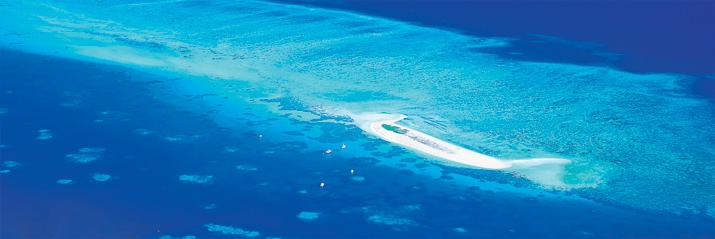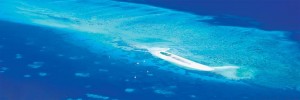
Many passengers travelling to the Great Barrier Reef will choose a variety of locations of a variety of reasons. Some passengers, brand new to snorkelling and travelling in large groups, will go to large pontoons, which are floating structures permanently fixed at a reef location. Many hard-core divers will take multi-day trips to some of the furthest sections of the outer reef. There are many fantastic locations to visit, and a person could spend every single day going to the reef for 100 years and still only see a fraction of all the locations, sights, and wildlife the reef has to offer. Today, we’ll look at one type of location many visitors flock to: Sand Cays.
A sand cay is a small, low-elevation, sandy island on the surface of a coral reef. Cays occur in tropical environments throughout the Pacific, Atlantic and Indian Oceans, and take thousands of years to form. A cay forms when ocean currents transport loose sediment across the surface of a reef to a low area, where the current slows or converges with another current, releasing its sediment load. Gradually, layers of deposited sediment build up on the reef surface. The island resulting from sediment accumulation is made up of biogenic sediment – the microscopic and small skeletal remains of plants and animals – from the surrounding reef ecosystems. Much of this sediment is comprised of coral skeleton—calcium carbonate—that has been processed though various species of parrotfish. As the parrotfish feed, their beak-like mouths scrape of algae off dead coral, taking small pieces of coral skeleton with it. The parrotfish then eliminate the sand, which falls to the reef floor in a very fine sandy powder.
Sand cays are also home to a great diversity of wildlife, both in the surrounding reef and on the cay itself. For example, Lady Elliot Island (actually a sand cay) host a large concentration of Manta rays due to the plankton-rich waters surrounding the area. Heron Island (again, technically a sand cay) is an important breeding ground for green sea turtles as well as many species of sea birds. Green Island (you guess it: sand cay) supports a range of vegetation, including dry coastal/beach plants and even a section of rain forest.
Michaelmas Cay, one of the most ecologically important sand cays on the reef, is visited by Passions of Paradise on a daily basis, and is home to over 17 different species of nesting and migratory sea birds. Michaelmas Cay is important as a breeding site for several species of terns. It has been identified by BirdLife International as an Important Bird Area (IBA) because it supports over 1% of the world populations of greater and lesser crested tern; Green turtles also sometimes nest on the cay. The surrounding reefs have a rich marine fauna, including giant clams. The cay also provides one of the few rare opportunities to snorkel and scuba dive in protected calm waters. No matter what the weather, the sandy lagoon is wind protected and the coral is immediately adjacent to the beach. Sea turtles are extremely common and you are also likely to see giant trevally, small black tip reef sharks, bat fish, and hundreds of varieties of colourful reef fish.
So if you’re seeking a one-of-a-kind reef experience, consider making the adventure out to one of the famous sand cays on the Great Barrier Reef. You will witness some amazing undersea life, stunning birds, and in general an amazing ecosystem. Whatever your plans, the sand cays of the Great Barrier Reef offer something for everyone!

